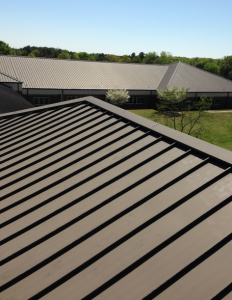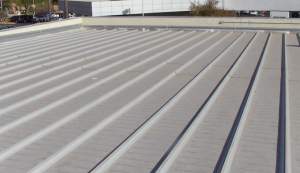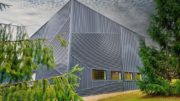A standing-seam metal roof system is a structural element of the building envelope and should therefore be designed like any other structural element of the building. An appropriately licensed engineer, licensed in the state where the work will be performed and experienced with metal roof designs, should be retained to determine the specific structural parameters associated with the standing-seam metal roof system.
The International Building Council (IBC) produces a code document that is used by all states as a basis for their individual state’s building code. This document requires wind-uplift forces be determined by referring to the Reston, Va.-based American Society of Civil Engineers’ ASCE 7 design document. Additionally, IBC requires the capacity of a selected metal roof panel should be determined using a UL-90-rated panel system or test results from an ASTM E-1592 panel test. The ASTM E-1592 test is better suited to determine variable panel clip supports and/or spacings required to resist the ASCE 7 design loads in specific areas of the roof.All metal roofs with slopes less than 3:12 should use hydrostatic panel attachments, as opposed to hydrokinetic, at the ends of the panels. If the roof has valleys, then this slope must increase to at least 4:12. A hydrostatic-acting connection is one that has a proper sealant between the metal roof surface and a metal flashing member, secured with a zinc-headed or stainless steel-headed fastener with an integral weatherseal washer. In contrast, the hemmed eaves and valleys used in a hydrokinetic design require positive water movement over these areas at all times. Because these conditions are where any panel movement must happen, these joints cannot be made watertight under hydrostatic pressure caused by driving winds and/or water buildup, panel bulging caused by wind forces over the panel surface or deterioration of caulk caused by differential movement of metal surfaces.
METAL ROOF INSTALLATION
For a standing-seam metal roof system to perform in the manner in which it was designed, the system must be installed as it was designed. This critical step requires retaining an experienced metal roofing contractor to erect the system as it was designed. It is highly recommended that a prequalification process be performed on any contractor that wishes to be responsible for the installation of a specific system. Metal roof manufacturers provide training to the metal roofing contracting crews and certify these persons to install their respective standing-seam roof systems. Often, this training and certification is necessary to provide manufacturer-backed warranties for materials and weathertightness.
The designer of the individual roof should be involved with the review of shop drawings and submittals, as well as the field inspections and job administration. If the owner requires, a fulltime field observer could be employed to monitor the work; however, periodic inspections throughout the life of the project should be sufficient.
A LONG LIFE
A Galvalume metal standing-seam roof system comprised of the metal panel, required trim and roof accessories will last as long as the other building components are intended. That timeframe, per LEED v4, with only minimal costs associated with ancillary roof components, is 60 years. The average life of the Galvalume-coated metal roof panel itself, per the MCA Galvalume study, is expected to be more than twice that amount.
To achieve these metal roof longevity results, it is imperative the roof system is properly designed by a professional engineer, installed by a manufacturer-certified installer, and inspected by the engineer and manufacturer periodically throughout the construction process. When these materials, engineering and installation come together as designed, the Galvalume metal standing-seam roof will have a life—without the need for total roof replacement—exceeding the expected life of the building. Now, that is true “infrastructure sustainability”.





Be the first to comment on "Galvalume-coated Metal Roofs Will Last at Least 60 Years with Minimal Component Repair"